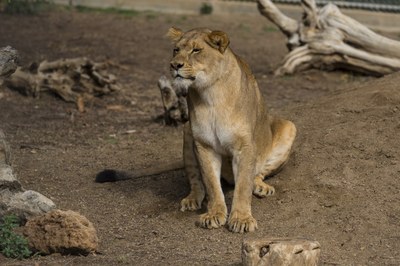African Lions
Learn about African lion conservation and see how your vision matches up to these big cats.
Learning Goal

The most researched big cat in the world is the African lion and it’s no surprise as to why: they have several unique adaptations. The first, and one of the most obvious adaptations, is that African lions are sexually dimorphic. This is just a scientific way of saying the males look different than the females. Adult male lions have the iconic mane of fur around their head, which is why they are often called “majestic” or “the king of the jungle.” Females lack this mane and are smaller than males; females can still reach up to 400 pounds and males can weigh in at about 570 pounds. Lions are also unique from other large cats because they live together in groups called prides. A pride of lions typically has one adult male, many adult females and their offspring. Prides may have as many as 30 individuals.

Living in prides also means that the roles and responsibilities for survival are spread out between male lions and the female lionesses. A lioness’s main jobs are to take care of the young and to hunt for food. Their smaller size compared to the male lions make them quicker ,and it's easier for them to chase down prey. The male lion's job is to protect the pride by marking their territory, patrolling the area, and staying on the lookout for any signs of danger.
African Lions at the ABQ BioPark

African Lion Conservation
Although not immediately threatened, lions still face dangers to survival. Though estimating the size of the African lion population across the continent is challenging, the International Union for the Conservation of Nature (IUCN) suspects a species population reduction of approximately 30 percent over the past two decades (this equates to approximately three lion generations). The main reasons for this decline includes indiscriminate killing of lions by humans to defend life and livestock, a decline in prey species (i.e. food availability), and lack of quality space and habitat.
The BioPark strives to help promote lion conservation through educating our visitors about lions and their importance in the ecosystem. In 2008-2009 a portion of the Zoo's Quarters for Conservation project went to the Lion Conservation Fund (LCF). LCF protects African lions by working with local communities. Through research, education and action, LCF develops sustainable solutions to lion-human conflicts
Night Vision Activity
Lions have excellent night vision to help them prowl around in the dark and hunt their prey. As humans, our night vision is definitely lacking; once our eyes get adjusted to the dark we can often see different shapes, but seeing and identifying color is near impossible! Our eyes rely on light to help us see color. You can do this activity to see how sensitive your eyes are to identifying color in dark places.
Materials you will need
- A dark room/closet with a little bit of light
- Paper
- Crayons
Directions
- Bring a piece of paper and some crayons with you into a dark space or room with very little light.
- Pick a crayon and draw a picture on your paper. Feel free to use more than one color and write out what crayon you think is each color.
- Come back into a lighted area and see which colors you got correct! Bright colors like yellow are usually easy to identify, even in the dark, but a lot of other colors such as red, green and blue appear to be different shades of brown or gray if there is no light to help us see them.
